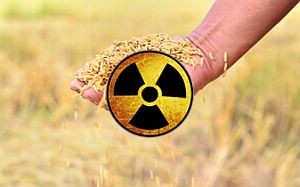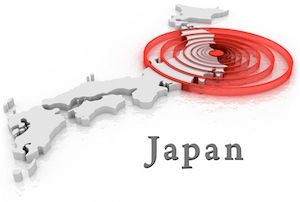David Gutierrez – The soil surrounding the crippled Fukushima Daiichi nuclear power plant remains contaminated with radioactive cesium, with a high risk that those atoms could transfer to food crops, suggests a study conducted by researchers from Kyoto Prefectural University and published in the Journal of Environmental Quality.
 The March 2011 earthquake and tsunami that hit Japan triggered multiple meltdowns at the Fukushima plant, causing the plant to eject a radioactive plume into the atmosphere that spread across Japan’s countryside and the northern hemisphere. More than 100,000 people were evacuated from the zone within 30 km (20 miles) of the plant.
The March 2011 earthquake and tsunami that hit Japan triggered multiple meltdowns at the Fukushima plant, causing the plant to eject a radioactive plume into the atmosphere that spread across Japan’s countryside and the northern hemisphere. More than 100,000 people were evacuated from the zone within 30 km (20 miles) of the plant.
Agricultural soil most toxic?
One of the main elements ejected from the plant was radioactive cesium, which dissolves easily into water and spreads quickly into the environment. In order to examine which types of soil are most likely to absorb radioactive cesium and which are most (or least) likely to pass it on to food grown there, the researchers conducted a survey of the physical and chemical properties of soil in rice fields around the crippled plant.
The major factor determining how easily radioactive cesium is taken up from soil is the “frayed edge site” (FES) concentration of the soil, which measures the soil’s content of minerals with rough or weathered edges. These rough edges bind to cesium, preventing it from leaving the soil. Unfortunately, FES is incredibly difficult to measure. A measurement that approximates FES is radiocesium interception potential (RIP), but RIP can only be measured in a lengthy process at specialized labs.
So the researchers tested with more easily measured variables that can be used to estimate RIP. They found that soils rich in potassium, clay or silt tended to have a higher RIP, and thus were more likely to hold on to radiocesium over time.
Alarmingly, soil rich in organic material and low in acidity — in other words, the best soil for growing food — was the most likely to allow radiocesium to migrate into plants. However, this soil could presumably be more easily bioremediated than soil with a higher RIP.
The bottom line: The soil around Fukushima is still highly radioactive, and is likely to remain so.
Government struggles with storing toxic soil
Radioactive soil from Fukushima was also in the news on March 25, when Japan’s Environment Ministry began the first transport of contaminated soil to the site of a planned temporary storage facility in the town of Futaba, in Fukushima Prefecture. Approximately 12 cubic meters of soil were transported to the site; about 246 cubic meters have also been transported to the site of the other planned temporary storage facility in Okuma.
According to the ministry, the first year of the transport process will be considered a trial period, as many details of the plan have yet to be finalized. During this time, the two temporary facilities will receive a total of 1,000 cubic meters of radioactive soil and debris, which is currently spread throughout 43 separate locations in the prefecture. This is less than 0.2 percent of the 22 million cubic meters of radioactive waste eventually intended for storage at the two sites.
The government has good reason to be tentative about its plan; even getting this far took years of negotiation with town officials and local landowners. Even now, the ministry has acquired less than 2 percent of the 16 square kilometers needed for the temporary facilities. Local landowners have been reluctant to sell their land for the facility, expressing concern that the storage facilities could become permanent once the government owns the land. Others have refused to sell land that has been in their families for generations.
According to the Environment Ministry, the radioactive waste will remain in the temporary facilities for 30 years. There is still no firm plan in place for the construction of a permanent storage facility, however.
Sources
SF Source Natural News April 2015
 L.J. Devon – If you drink tap water, there’s a good chance you’re taking in all sorts of pharmaceutical drugs at the same time. Massive doses of prescription drugs pass through people’s bodies and into the sewage system. These chemicals are very stable and make their way back into the water supply, unchanged. If you don’t use appropriate, lab-validated water filters, you could be drinking a bizarre cocktail of drugs on a daily basis. Without even knowing it, you could be taking birth control, statins, SSRIs, psychotics, or any other popular chemical that is now pervasive in the water supply. These second hand medications could be interfering with your hormones, weight modulation, sleep patterns, temperament, cognitive function, ability to handle stress, etc.
L.J. Devon – If you drink tap water, there’s a good chance you’re taking in all sorts of pharmaceutical drugs at the same time. Massive doses of prescription drugs pass through people’s bodies and into the sewage system. These chemicals are very stable and make their way back into the water supply, unchanged. If you don’t use appropriate, lab-validated water filters, you could be drinking a bizarre cocktail of drugs on a daily basis. Without even knowing it, you could be taking birth control, statins, SSRIs, psychotics, or any other popular chemical that is now pervasive in the water supply. These second hand medications could be interfering with your hormones, weight modulation, sleep patterns, temperament, cognitive function, ability to handle stress, etc.
 The image of a woman, shocked and disoriented, completely covered in dust from the demolition of the Twin Towers, brings the nearly incomprehensible events of that day down to a human scale.
The image of a woman, shocked and disoriented, completely covered in dust from the demolition of the Twin Towers, brings the nearly incomprehensible events of that day down to a human scale. Arjun Walia – As most of you reading this already know, 2011 bore witness to one of the darkest days of human environmental history. That year, a nuclear disaster occurred at the Fukushima Nuclear Power Plant after a massive 9.0 earthquake triggered a tsunami, resulting in the nuclear meltdown of three of the plant’s six nuclear reactors.
Arjun Walia – As most of you reading this already know, 2011 bore witness to one of the darkest days of human environmental history. That year, a nuclear disaster occurred at the Fukushima Nuclear Power Plant after a massive 9.0 earthquake triggered a tsunami, resulting in the nuclear meltdown of three of the plant’s six nuclear reactors. The March 2011 earthquake and tsunami that hit Japan triggered multiple meltdowns at the Fukushima plant, causing the plant to eject a radioactive plume into the atmosphere that spread across Japan’s countryside and the northern hemisphere. More than 100,000 people were evacuated from the zone within 30 km (20 miles) of the plant.
The March 2011 earthquake and tsunami that hit Japan triggered multiple meltdowns at the Fukushima plant, causing the plant to eject a radioactive plume into the atmosphere that spread across Japan’s countryside and the northern hemisphere. More than 100,000 people were evacuated from the zone within 30 km (20 miles) of the plant. So you walked the path prescribed for you, making certain that you acquired all the requirements for success. You maintained good grades in school and never caused trouble, for you knew the importance of a good reputation. You played well with others.
So you walked the path prescribed for you, making certain that you acquired all the requirements for success. You maintained good grades in school and never caused trouble, for you knew the importance of a good reputation. You played well with others.